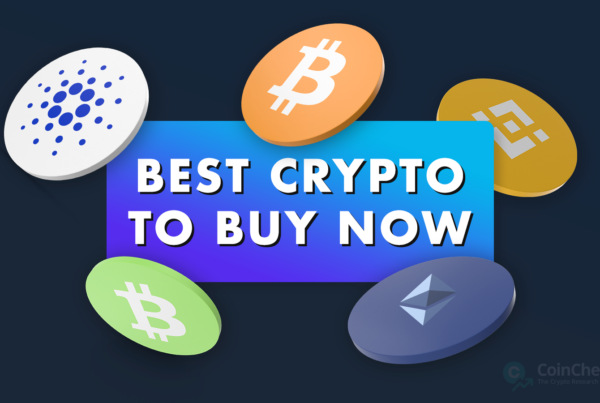After another week of rather sideways trading on the cryptocurrency markets we are entering already 6th week of 2022, which will hopefully bring more green numbers to crypto charts and higher gains of your crypto portfolio. While it is impossible to predict, in which direction the markets will move, we hand-pick 3 coins that have the highest potential for appreciation each week. Find out this week’s selection in the article below.

3. Ethereum Classic (ETC)
Ethereum Classic emerged through a hard fork of the Ethereum blockchain in 2016 following the controversial debate around how the community should respond to the DAO hack, in which $50 million worth of ETH were stolen. Most of the community voted that the stolen funds should be reimbursed and the chain in which the illicit transaction was reversed lives on as the Ethereum main chain. However, some Ethereum developers and users believed immutability was a crucial aspect of blockchains and that hard forks should not be used to reverse the transactions that happened on the Ethereum blockchain. This camp did not reverse the DAO hack transactions in the hard fork and their chain became known as Ethereum Classic. Widely regarded as the only Ethereum fork of significance, Ethereum Classic maintains the continuity of the Ethereum blockchain using Proof-of-Work consensus algorithm and there are currently no plans to transition to Proof-of-Stake. As opposed to ETH, the total supply of ETC is capped at 210 million ETC.
Ethereum Classic Blockchain to undergo Mystique hard fork on February 13th
Mystique is an upgrade that will bring a subset of the ECIPs, similar to the EIPs deployed on Ethereum in August 2021 as part of the London hard fork, to the Ethereum Classic network. Nevertheless, the Mystique hard fork is not exactly a copy-paste of the London hard fork as the Ethereum Classic community decided to opt-out of deploying some of the EIPs from the London upgrade. The omitted improvements include the EIP that implemented the real-time fee burning mechanism to Ethereum because the fee market change conflicts with ETC’s fixed monetary policy. In addition, the Mystique hard fork will not feature the difficulty bomb delay EIP because ETC has previously entirely removed the difficulty bomb. You can find all the details about the protocol upgrades featured in the hard fork in ECIP-1104 description. The Mystique hard fork will be activated on the Ethereum Classic mainnet at block 14,525,000, which is estimated to be mined on February 13th, 2022. All node operators should upgrade to Mystique ready clients, which include Core-geth v1.12.4 or later and Hyperledger Besu v21.10.8 or later.

2. FTX Token (FTT)
FTX is a cryptocurrency derivatives exchange that offers futures, leveraged ERC-20 tokens, and OTC trading. The developers of the FTX exchange aim to offer a first-class trading experience by constantly improving the platform and addressing the issues that are often left unaddressed on other mainstream exchanges. FTX focuses on developing and offering institutional-grade solutions. The official token and the backbone of the FTX cryptocurrency derivatives exchange is FTX Token (FTT). The maximum supply of FTT is 350 million tokens, but the exchange uses one-third of all fees collected from the trades to buy back and burn FTT. Users of the exchange can utilize FTT as collateral for futures positions use it for earning rebates on trading fees or even stake the coins. Furthermore, the exchange promises to add more FTT use cases in the future.
FTX ecosystem grows its user base as well as its valuation
The FTX exchange is recently experiencing growth on several counts. Since October 2021, the FTX’s user base grew by more than 60%, which in turn resulted in a 40% increase of the average daily trading volume, which now hovers around $14 billion. In fact, the exchange now claims the title of the third-largest crypto exchange in the world and the largest exchange outside of China. Nevertheless, the crypto conglomerate seeks to further expand its reach and number of users by acquiring a licensed Japanese crypto trading platform, Liquid. FTX is also thinking about the future. To secure its leading spot in the blockchain space in the following years, the company launched FTX Ventures, a $2 billion venture fund that primarily invests in innovative blockchain, cryptocurrency, and Web3 solutions. To conclude, the increase of trading activity on the platform has led to an appreciation of the FTX conglomerate. According to the press release following the latest Series C funding round, in which the FTX exchange raised $400 million, the exchange is now valued at more than $32 billion. The valuation of FTX already surpasses the market cap of some of the biggest publicly traded companies in the world.

1. Solana (SOL)
Solana is a smart contract-enabled blockchain platform developed with a focus on scalability. Due to its high throughput of 65,000 transactions per second and absurdly low transaction fees (an average transaction on the blockchain costs just $0.00025), Solana is considered one of the strongest Ethereum competitors. Such a high blockchain efficiency is made possible by utilizing an innovative proof-of-stake consensus mechanism combined with a proof-of-history (PoH) timestamping mechanism. Because of these reasons, Solana is very popular among various non-fungible token (NFT) projects and decentralized finance applications of all kinds. In addition, the project is also backed by major investors such as Alameda Research, Polychain, and Andreessen Horowitz that provide Solana Labs with more than sufficient funds for further development of the Solana blockchain.
Solana rally almost nullified by the Solana-Ethereum bridge exploit
At the very beginning of this month, Solana’s SOL rallied by more than 20%. The price started surging soon after Coinbase announced the listing of two Solana-based assets: Bonfida (FIDA) and Orca (ORCA), which became the first Solana-based tokens as well as the first non-Ethereum or Layer 1 native tokens to commence trading on the popular exchange. The rally was further fuelled by the roll-out of Solana Pay, a novel peer-to-peer (P2P) payments protocol that facilitates low-cost and fast USDC payments to merchants worldwide. Solana Labs, which developed the new service, hope that Solana Pay will help boost Solana’s adoption, especially in the e-commerce sector. Both events combined caused SOL to climb from around $90 in the evening hours of January 31 to above $110 on February 1. However, the price gain was not sustained as SOL began tanking in the night from February 2 to February 3 as news about a major exploit of Wormhole, a bridge between the Ethereum and Solana network, hit Twitter. Reportedly, hackers managed to mint 120k wETH by depositing just 0.1 ETH by exploiting a bug in the Solana smart contract. The hacker soon sold his unrightfully obtained wETH for over 90.000 ETH, worth over $240 million. SOL price dropped by more than 10% falling as low as $95 on February 3. At the time of writing SOL has recovered back above $100, but it is still trading 10% below this rally’s top. It will be interesting to observe whether positive ecosystem developments or negative implications stemming from the attack will prevail in the coming week. Given the fact that Wormhole developers have taken a very proactive approach and have patched the bug almost immediately, suggests that the SOL price trend could soon be pointing back up.



